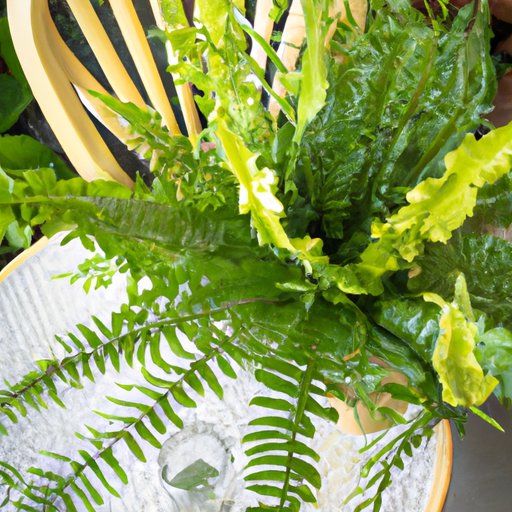
Introduction
As a houseplant enthusiast, you may want to add ferns to your plant collection. But it’s not always easy to keep them looking their best. In this article, we will provide you with the ultimate guide to caring for ferns, including tips and tricks on choosing the right fern, creating the perfect conditions for growth, basic care, and common mistakes to avoid. We’ll also give you creative ideas on how to display your ferns in your home.
The Ultimate Guide to Fern Care: Tips and Tricks
Choosing the right fern for your space is key to keeping it healthy and thriving. Consider the light, water, soil, and temperature requirements for each fern and choose one that meets your specific needs. Examining the plant for a healthy root system and fronds that are whole and free of damage can indicate that you’re purchasing a healthy plant. Now, once you have the right fern for your space, focus on creating the perfect conditions for growth. Ferns thrive in low to medium light, high humidity, and damp soil. They like to be kept moist but not soaked, and should never be left sitting in standing water. Creating optimal conditions for all fern types will help them thrive.
Ferns 101: How to Keep Your Ferns Looking Lush and Green
Ferns need specific care to ensure they stay looking their best. Proper watering, fertilizing, and pruning all play important roles. Overwatering is the most common way to kill a fern. The plant itself should never be left sitting in standing water, and the soil should be kept slightly damp. Fertilizer can be added to the soil every other month, but making sure the plant is in the right lighting conditions is more important than fertilization. Pruning should be used to remove yellowing fronds or to control the size of the plant if it gets too bushy. And if you notice common problems like yellowing leaves or pests, address them promptly to keep the plant healthy. If your fern is struggling to grow, several things can be done to give it the help it needs. First, water it in the sink, allowing water to flow through the soil, then set it back in place. Remove any briwn or damaged fronds, and place it in a humid area.
The Top 5 Mistakes to Avoid When Caring for Your Ferns
Common mistakes can be made when caring for ferns. Over-watering, sunlight-exposure, soil choice, and over-fertilization are common causes of issues. When watering, it’s important to not let the plant sit in standing water as it can affect the roots and cause them to rot. Ferns also need to be in an area away from direct sunlight as they are shade-loving plants and will burn in too much sun. It’s crucial to use the right kind of soil for your ferns. Most prefer a well-draining soil with a good amount of peat moss mixed in. Lastly, avoid over-fertilizing your ferns, as they don’t need very much of it, and it can harm the plant if overused.
Creating a Perfect Fern Oasis in Your Home: Creative Ideas for Displaying Your Ferns
Ferns aren’t just good for our homes but are also soothing and peaceful to look at. Utilizing hanging baskets are a fun way to incorporate ferns into your home decor. Mounting ferns onto planks of wood to create a living wall of ferns is another creative way to display them. Finally, creating a mini fern garden in a terrarium is an exciting way to decorate your home. Choosing the correct location to display your ferns is important. You’ll want to consider a spot with the correct lighting and moisture levels suitable for the fern you choose.
Going Beyond Basic Fern Care: Advanced Techniques for Healthier Plants
In addition to basic plant care, there are advanced techniques like propagation and fern division. Propagation can be done through spores and needs to be handled carefully. Dividing a fern can help keep it healthy, but this technique should be done under specific conditions as needed. Understanding how to spot more complex issues like heat stress or pests can help you identify and address issues before they take the life of the fern.
Conclusion
Remember, with the right conditions and basic care, ferns can be a beautiful addition to your home. From choosing the right plant and optimal growing conditions to basic care and creative ideas for displaying your ferns, we hope this guide has given you the knowledge and confidence to care for your ferns. Don’t be afraid to try and grow ferns yourself, it can be a fulfilling and rewarding experience. Remember, with a little love and care, your ferns can bring joy and peace to your home.





